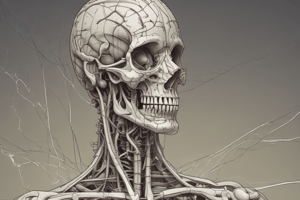Podcast
Questions and Answers
Which of the following effects is NOT associated with the sympathetic nervous system?
Which of the following effects is NOT associated with the sympathetic nervous system?
- Bronchodilation
- Stimulation of glucose release from the liver
- Pupil constriction (correct)
- Increased heart rate
What type of receptor is found in the heart, responsible for decreasing heart rate?
What type of receptor is found in the heart, responsible for decreasing heart rate?
- Alpha-1
- Beta-1
- Muscarinic M2 (correct)
- Nicotinic
Which of the following is TRUE about the sympathetic nervous system?
Which of the following is TRUE about the sympathetic nervous system?
- Its primary neurotransmitter is acetylcholine.
- It originates in the cranial and sacral regions of the spinal cord.
- It primarily promotes 'rest and digest' activities.
- It primarily acts on adrenergic receptors. (correct)
Where are nicotinic receptors found?
Where are nicotinic receptors found?
The parasympathetic nervous system is responsible for which of the following effects?
The parasympathetic nervous system is responsible for which of the following effects?
Which receptor type is primarily responsible for vasoconstriction?
Which receptor type is primarily responsible for vasoconstriction?
Which of the following statements is TRUE about the parasympathetic nervous system?
Which of the following statements is TRUE about the parasympathetic nervous system?
Which receptor type is NOT involved in controlling the heart's function?
Which receptor type is NOT involved in controlling the heart's function?
Flashcards
Sympathetic Nervous System (SNS)
Sympathetic Nervous System (SNS)
Part of the autonomic nervous system that prepares the body for 'fight or flight'.
Function of SNS
Function of SNS
Prepares for vigorous activity by increasing heart rate and inhibiting digestion.
Effects of SNS
Effects of SNS
Increases heart rate, dilates bronchioles, constricts blood vessels in non-essential organs.
Adrenergic Receptors
Adrenergic Receptors
Signup and view all the flashcards
Parasympathetic Nervous System (PNS)
Parasympathetic Nervous System (PNS)
Signup and view all the flashcards
Function of PNS
Function of PNS
Signup and view all the flashcards
Cholinergic Receptors
Cholinergic Receptors
Signup and view all the flashcards
Key Differences between SNS & PNS
Key Differences between SNS & PNS
Signup and view all the flashcards
Study Notes
Sympathetic Nervous System (SNS)
- Function: Prepares the body for "fight or flight" responses, active during stress, danger, or vigorous activity.
- Effects:
- Increases heart rate and force of contraction.
- Dilates bronchioles in the lungs.
- Dilates pupils.
- Inhibits digestion.
- Stimulates glucose release from the liver.
- Constricts blood vessels in non-essential organs and dilates them in muscles.
- Receptors: Adrenergic receptors respond to adrenaline (epinephrine) and noradrenaline (norepinephrine).
- Alpha receptors:
- Alpha-1: Causes vasoconstriction in blood vessels.
- Alpha-2: Found in the CNS and presynaptic nerve terminals, modulating neurotransmitter release.
- Beta receptors:
- Beta-1: Increases heart rate and force of contraction in the heart.
- Beta-2: Causes bronchodilation and vasodilation in lungs and skeletal muscle blood vessels.
- Alpha receptors:
Parasympathetic Nervous System (PNS)
- Function: Promotes "rest and digest" activities, active during restful periods, conserving energy.
- Effects:
- Decreases heart rate.
- Constricts bronchioles in the lungs.
- Constricts pupils.
- Stimulates digestion and peristalsis.
- Promotes glucose storage in the liver.
- Dilates blood vessels in the gastrointestinal tract.
Receptors (General)
- Cholinergic Receptors: Respond to acetylcholine.
- Muscarinic Receptors:
- M1: Found in CNS and gastric parietal cells, involved in cognitive function and gastric acid secretion.
- M2: Found in the heart, decreases heart rate.
- M3: Found in smooth muscles and glands, causes smooth muscle contraction and glandular secretion.
- M4 and M5: Found in the CNS, involved in various central nervous system functions.
- Nicotinic Receptors: Found in autonomic ganglia (both SNS and PNS) and neuromuscular junctions; transmit nerve impulses to muscles.
- Muscarinic Receptors:
Key Differences
- Origin:
- Sympathetic: Thoracic and lumbar regions of spinal cord (T1-L2).
- Parasympathetic: Cranial nerves (III, VII, IX, X) and sacral spinal cord (S2-S4).
- Neurotransmitters:
- Sympathetic: Primarily norepinephrine/noradrenaline.
- Parasympathetic: Primarily acetylcholine.
- Responses:
- Sympathetic: Widespread, longer-lasting effects due to adrenaline release from adrenal medulla.
- Parasympathetic: Localized, shorter-lasting effects.
Studying That Suits You
Use AI to generate personalized quizzes and flashcards to suit your learning preferences.




